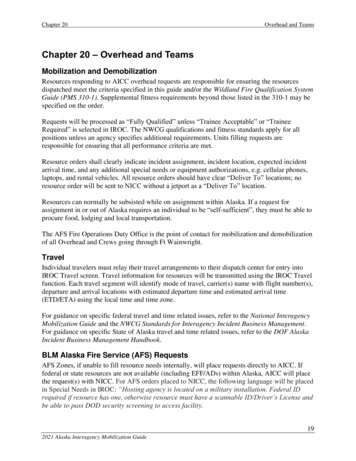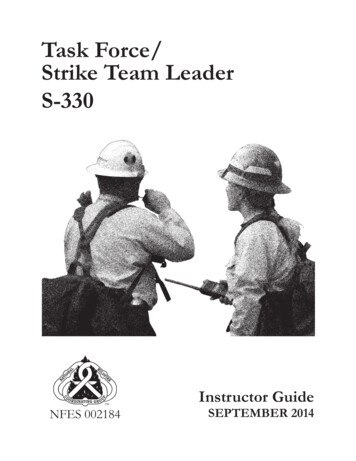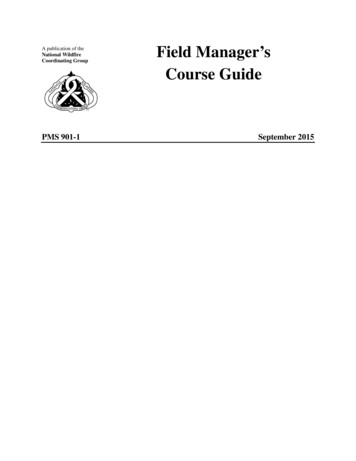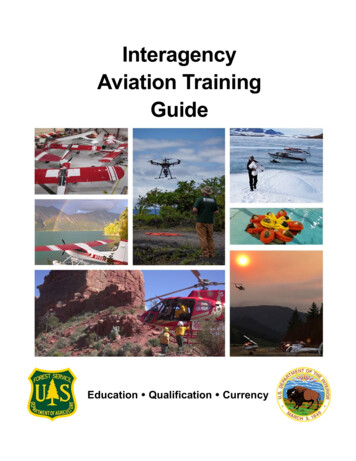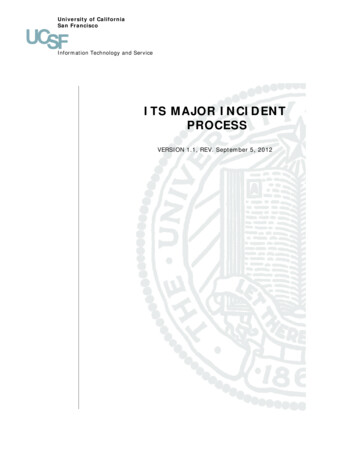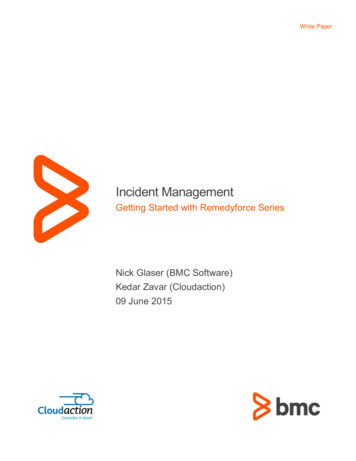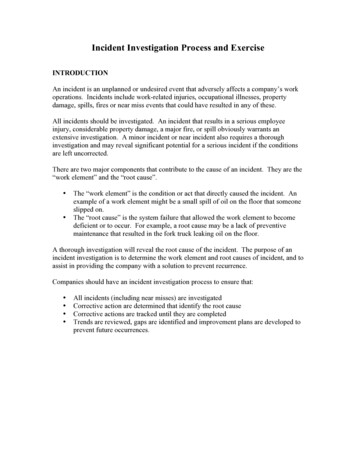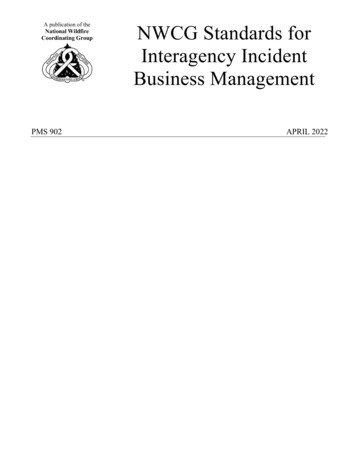
Transcription
A publication of theNational WildfireCoordinating GroupPMS 902NWCG Standards forInteragency IncidentBusiness ManagementAPRIL 2022
NWCG Standards for InteragencyIncident Business ManagementApril 2022PMS 902The NWCG Standards for Interagency Incident Business Management, assists participating agencies ofthe NWCG to constructively work together to provide effective execution of each agency’s incidentbusiness management program by establishing procedures for: Uniform application of regulations on the use of human resources, including classification,payroll, commissary, injury compensation, and travel. Acquisition of necessary equipment and supplies from appropriate sources in accordance withapplicable procurement regulations. Management and tracking of government property. Financial coordination with the jurisdictional agency and maintenance of finance, property,procurement, and personnel records, and forms. Use and coordination of incident business management functions as they relate to sharing ofresources among federal, state, and local agencies, including the military. Documentation and reporting of claims. Documentation of costs and cost management practices. Administrative processes for all-hazards incidents.Uniform application of interagency incident business management standards is critical to successfulinteragency fire operations. These standards must be kept current and made available to incident andagency personnel. Changes to these standards may be proposed by any agency for a variety of reasons:new law or regulation, legal interpretation or opinion, clarification of meaning, etc. If the proposedchange is relevant to the other agencies, the proponent agency should first obtain national headquarters’review and concurrence before forwarding to the NWCG Incident Business Committee (IBC). IBC willprepare draft NWCG amendments for all agencies to review before finalizing and distributing.The National Wildfire Coordinating Group (NWCG) provides national leadership to enable interoperablewildland fire operations among federal, state, tribal, territorial, and local partners. NWCG operations standardsare interagency by design; they are developed with the intent of universal adoption by the member agencies.However, the decision to adopt and utilize them is made independently by the individual member agencies andcommunicated through their respective directives systems.
NWCG STANDARDS FORINTERAGENCY INCIDENT BUSINESS MANAGEMENTChapter 10PersonnelChapter 20AcquisitionChapter 30Property ManagementChapter 40Incident Business Management CoordinationChapter 50Interagency Cooperative RelationsChapter 60Accident Investigation and ReportingChapter 70ClaimsChapter 80Cost Accounting and ReportingChapter 90All-Hazards Incident Business ManagementAppendix ANWCG Standards for Interagency Incident Business ManagementTool Kiti
Table of ContentsChapter 10 – Personnel . 10-1Resources . 10-1Organized Crews . 10-1Casuals . 10-2Hiring of 16 and 17 Year Olds. 10-3Job Corps and Youth Conservation Corps (YCC) Enrollees . 10-3Hiring of Federal Retirees . 10-3Volunteers Under Formal Agreement . 10-4Using Regular Government Employees from Federal Agencies . 10-4Cooperators . 10-4Pay Provisions. 10-5Incident Pay Guidelines . 10-5One-Day Assignments (0001 to 2400 Hours). 10-5Multiple-Day Assignments . 10-5Last Day of the Incident Assignment. 10-6Detail Assignments . 10-7Off-Site/Remote Incident Assignments . 10-7On-Shift Time . 10-9Travel and Related Waiting Time . 10-9Ordered Standby . 10-10On-Call. 10-11Off-Shift Time . 10-11Meal Periods . 10-12Work/Rest, Length of Assignment, and Days Off . 10-12Work/Rest Guidelines . 10-13Incident Operations Driving . 10-13Length of Assignment . 10-14Management Directed Days Off at Home Unit . 10-16Other Pay Provisions. 10-16Hazard Pay for GS Employees . 10-17Definitions for Hazard Pay Purposes . 10-18Positions Not Entitled to Hazard Pay Differential for Irregular and Intermittent Hazardous Duties. 10-18Criteria for Entitlement to Hazardous Pay Differential for Irregular and Intermittent HazardousDuties (5 CFR 550.904) . 10-18Regulations Governing Payment of Hazard Differential for GS Employees . 10-19Environmental Differential for Federal Wage System Employees (5 CFR 532.511) . 10-20Criteria for Entitlement to Environmental Differential for Federal Wage System Employees10-20Regulations Governing Payment of Environmental Differential. 10-21Public Law 106-558 . 10-22Fair Labor Standards Act (FLSA) Exemption Modifications for Emergency Assignments . 10-22Reasonable Accommodations . 10-23Personnel Timekeeping/Recording . 10-23Crew Time Report (CTR), SF-261 . 10-25Timekeeping Methods . 10-26Incident Time Report, OF-288 for Regular Government Employees. 10-26NWCG Standards for Interagency Incident Business Managementii
Hiring and Payment of Casual Employees . 10-27Closing Out Incident Time Reports . 10-28Common Timekeeping Issues . 10-29Exhibits . 10-29Exhibit 1 – AD Pay Plan for Emergency Workers . 10-30Exhibit 2 – Example 1, Crew Time Report (CTR), SF-261 . 10-30Exhibit 2 – Example 2, Crew Time Report (CTR), SF-261 . 10-31Exhibit 3 – Incident Time Report, OF-288 for Regular Government Employees . 10-32Exhibit 4 – Incident Time Report, OF-288 for Casual Employees. 10-33Exhibit 5 – Employment Eligibility Verification, Form I-9 . 10-34Exhibit 6 – Checklist for Closing out the Incident Time Report, OF-288. 10-34Exhibit 7 – NWCG Single Resource Casual Hire Information Form, PMS 934 . 10-35Exhibit 8 – Incident Behavior Form, PMS 935-1 . 10-35Exhibit 9 – Comportamiento En Incidentes Form, PMS 935-2. 10-35Exhibit 10 – Exempt / Nonexempt Positions . 10-36Commissary . 10-39Commissary Procedures. 10-39Commissary Privileges – Payroll Deduction . 10-39Commissary Privileges – Contractors. 10-40Agency-Provided Commissary . 10-40Ordering/Receiving Procedures . 10-40Commissary Issue Record. 10-40Posting Commissary Issues. 10-41Exhibits . 10-41Exhibit 11 – Commissary Issue Record, OF-287 . 10-42Exhibit 12 – Commissary Accountability Record, OF-284 . 10-43Compensation for Injury/Illness . 10-45Federal Workers’ Compensation . 10-46Federal Employees’ Compensation Act (FECA) . 10-46Coverage Under FECA . 10-46Authorizing Medical Care. 10-47Continuation of Pay (COP) . 10-47Selection of Physician . 10-49Agency Provided Medical Care (APMC) . 10-49Authority for APMC . 10-49APMC Coverage . 10-49Procedures to Establish APMC . 10-50Payment of APMC Costs . 10-50Procedures for Using APMC . 10-50Procedures and Documentation Requirements for FECA or APMC. 10-51Traumatic Injury . 10-51Occupational Disease/Illness . 10-52Prescriptions . 10-52Fatality . 10-52Forms Distribution . 10-53State and Local Government Workers’ Compensation . 10-53State Workers’ Compensation Coverage . 10-53Local Government Workers’ Compensation . 10-54NWCG Standards for Interagency Incident Business Managementiii
Exhibits . 10-54Exhibit 13– Federal Employee’s Notice of Traumatic Injury and Claim for Continuation ofPay/Compensation, CA-1 . 10-54Exhibit 14 – Notice of Occupational Disease and Claim for Compensation, CA-2 . 10-54Exhibit 15 – Authorization for Examination and/or Treatment, CA-16 . 10-55Exhibit 16 – Agency Provided Medical Care Authorization and Medical Report, FS-6100-16 . 1056Exhibit 17 – Incident Injury/Illness Log . 10-58Exhibit 18 – OF-288 Example with COP for a Regular Federal Employee . 10-59Exhibit 19 – OF-288 Example with COP for Casual Employee . 10-60Exhibit 20 – Incident Injury Case File Envelope, OF-313 . 10-61Travel . 10-62Travel Procedures . 10-62Incident Agency Requirements . 10-62Foreign Travel. 10-64Chapter 20 – Acquisition . 20-1Delegations of Procurement Authority . 20-1Incident Requisitioning Procedures . 20-2Incident Agency Service and Supply Plan . 20-2Sources of Supply . 20-3National Cache System . 20-3General Services Administration (GSA) . 20-3Defense Logistics Agency (DLA) . 20-3National Contracts . 20-3Acquisition Methods . 20-4Government Charge Cards and Convenience Checks . 20-4Land Use and Facility Rental Agreements . 20-4Equipment Rental. 20-5Ordering Equipment. 20-5General Guidelines for Equipment Hire . 20-6Hiring Methods . 20-7Incident-Only EERAs . 20-7Incident-Only EERA and LUA Administrative Changes . 20-8Unique Items . 20-8Agency-Provided Commissary Requisitions . 20-8Agency-Provided Commissary Acquisition . 20-9Commissary Returns . 20-9Government Telephone Systems . 20-9Agency Provided Medical Care (APMC) . 20-9Subsistence and Lodging Provisions . 20-9Military . 20-11Water . 20-11Awards . 20-11EERA and IBPA Administration . 20-11Ordering . 20-11Inspections . 20-12Documentation . 20-12Forms Distribution . 20-14NWCG Standards for Interagency Incident Business Managementiv
Equipment Release. 20-14Contract Claims . 20-15EERA and IBPA Claims Settlement . 20-16Payments . 20-16Emergency Equipment Rental Agreement (EERA) and Incident Blanket Purchase Agreement(IBPA) . 20-17National Contracts . 20-17Exhibits . 20-18Exhibit 21 – Equipment and Method of Hire National Standards . 20-19Exhibit 22 – Sample Report from Automated Dispatch System . 20-35Exhibit 23 – Emergency Equipment Rental Agreement (EERA), OF-294 . 20-35Exhibit 24 – Vehicle/Heavy Equipment Pre-Use Inspection Checklist, OF-296. 20-36Pre-Use Inspection . 20-39Release . 20-39Exhibit 25 – Emergency Equipment Shift Ticket, OF-297. 20-40Exhibit 26 – Emergency Equipment Use Invoice, OF-286 . 20-41Exhibit 27 – Emergency Equipment Fuel and Oil Issue, OF-304 . 20-42Exhibit 28 – Emergency Equipment Rental-Use Envelope, OF-305 . 20-43Exhibit 29 – Solicitation / Contract/Order for Commercial Items, SF-1449 . 20-43Exhibit 30 – Incident Demobilization Vehicle Safety Inspection (ICS-212) . 20-43Exhibit 31 – Commercial Rental/Service Envelope . 20-44Exhibit 32a – Emergency Facilities & Land Use Agreement, PMS 902-2 . 20-44Exhibit 32b – Emergency Facilities & Land Use Agreement Checklists and General Guidance. 20-44Chapter 30 – Property Management . 30-1Property Management Program Procedures . 30-1Incident Base Security/Storage . 30-2Property Receipting Procedures. 30-2Identification . 30-2Property Accountability Controls . 30-3Clearance and Demobilization Procedures . 30-5Donations . 30-6Recycling at Incident Base. 30-7Exhibits . 30-7Exhibit 33 – Interagency Incident Waybill, OF-316 . 30-8Exhibit 34 – Buying Team Incident Waybill, PMS 902-1 . 30-11Exhibit 35 – Incident Replacement Requisition, OF-315 . 30-11Exhibit 36 – Property Loss or Damage Report Fire Suppression, OF-289 . 30-11Chapter 40– Incident Business Management Coordination . 40-1Incident Agency Coordination . 40-1IMT Coordination . 40-2BUYT Coordination. 40-3Administrative Payment Team (APT) Coordination . 40-3Incident Information Technology Coordination . 40-3Other Team Coordination . 40-4Exhibits . 40-4Exhibit 37 – Time Unit Incident Finance Package Guidelines . 40-5Exhibit 38 – Commissary Incident Finance Package Guidelines . 40-5NWCG Standards for Interagency Incident Business Managementv
Exhibit 39 – Compensation/Claims Unit Incident Finance Package Guidelines . 40-6Exhibit 40 – Procurement Unit Incident Finance Package Guidelines . 40-6Exhibit 41 – Cost Unit Incident Finance Package Guidelines . 40-7Chapter 50– Interagency Cooperative Relations . 50-1Formal Agreements. 50-1Agreements Between U.S. Government Agencies . 50-1Agreements with Tribes . 50-2Agreements Between Federal, State Fire Organizations and Local Governments . 50-2Agreements with Foreign Government Entities . 50-2Cost Share Agreements for Multi-Jurisdiction Incidents. 50-3State Fire Management Assistance . 50-3Authority . 50-3Process . 50-3Military Involvement . 50-4Authority . 50-4Responsibility . 50-4Modular Airborne Fire Fighting System (MAFFS) . 50-4Military Costs and Billings . 50-4Chapter 60 – Accident Investigation and Reporting . 60-1Chapter 70 – Claims .
A publication of the National Wildfire Coordinating Group . NWCG Standards for Interagency I
